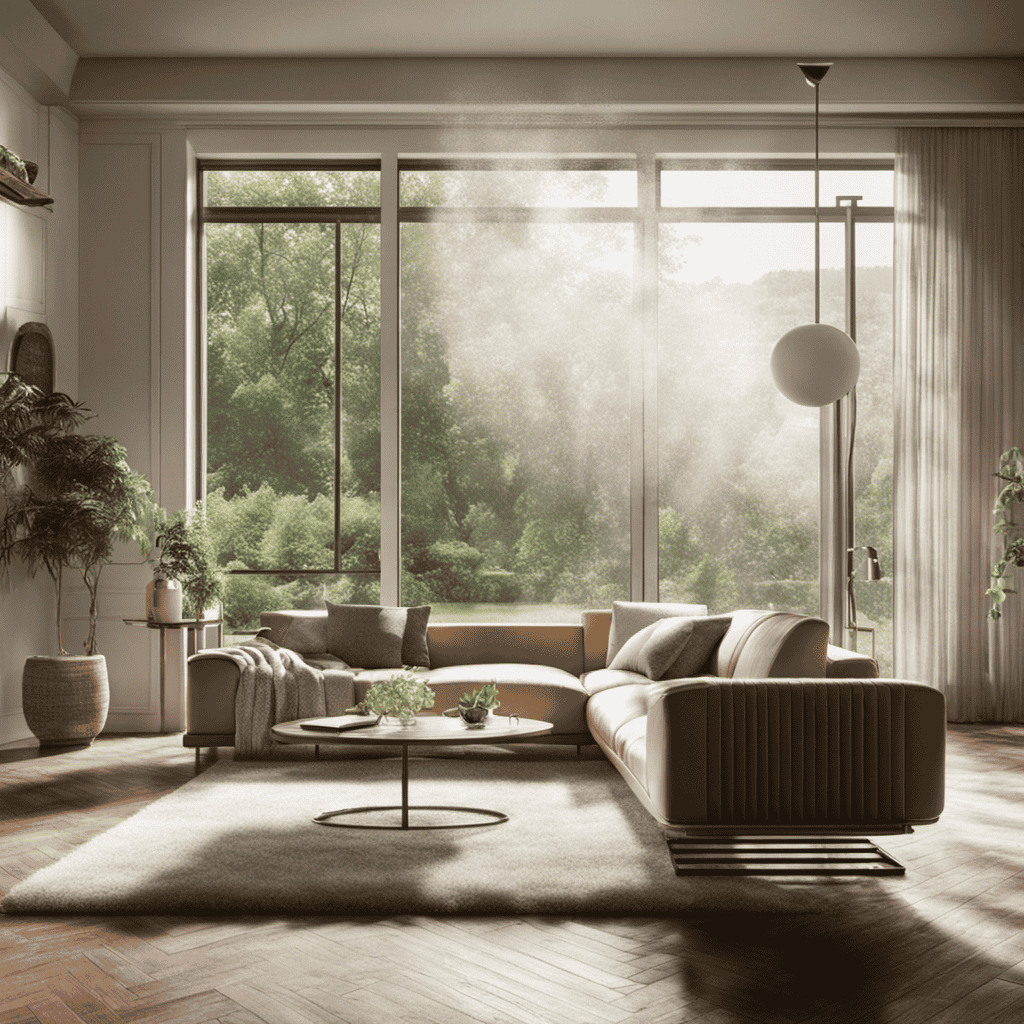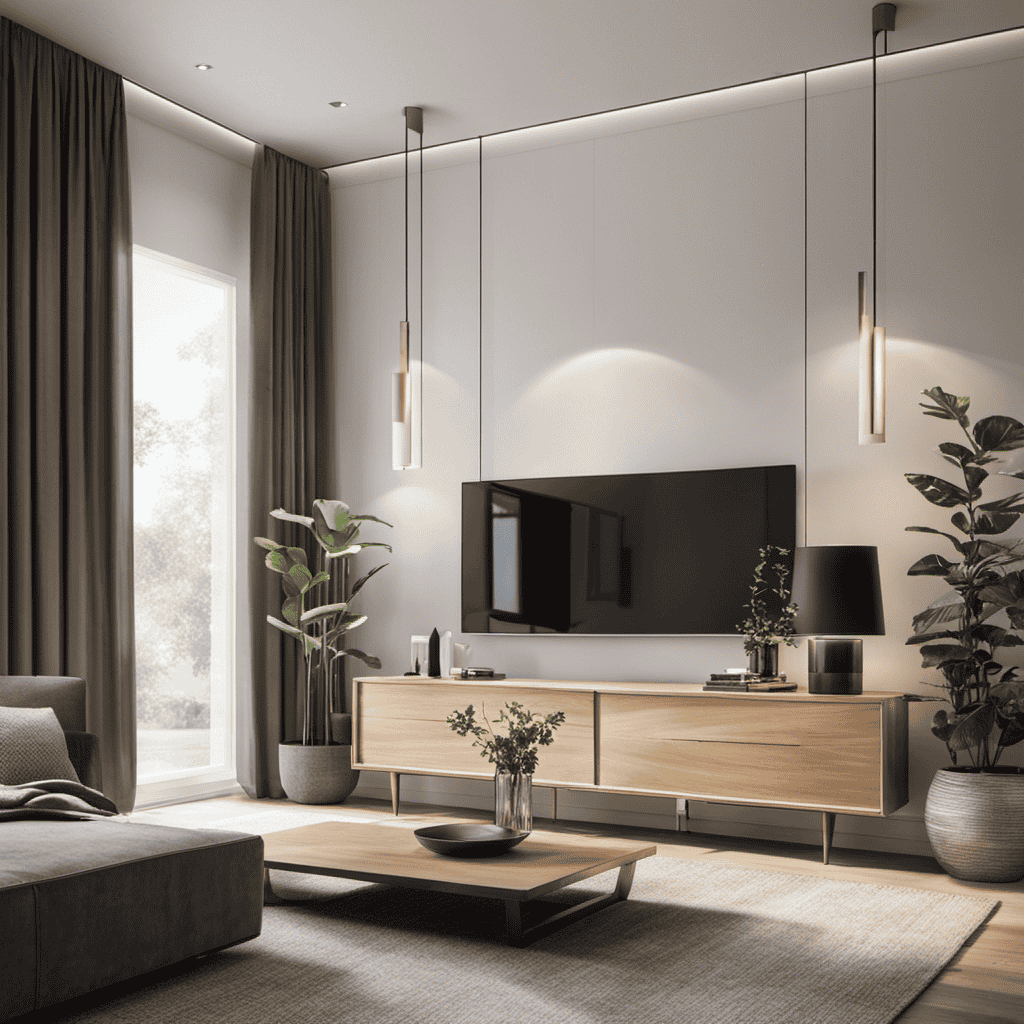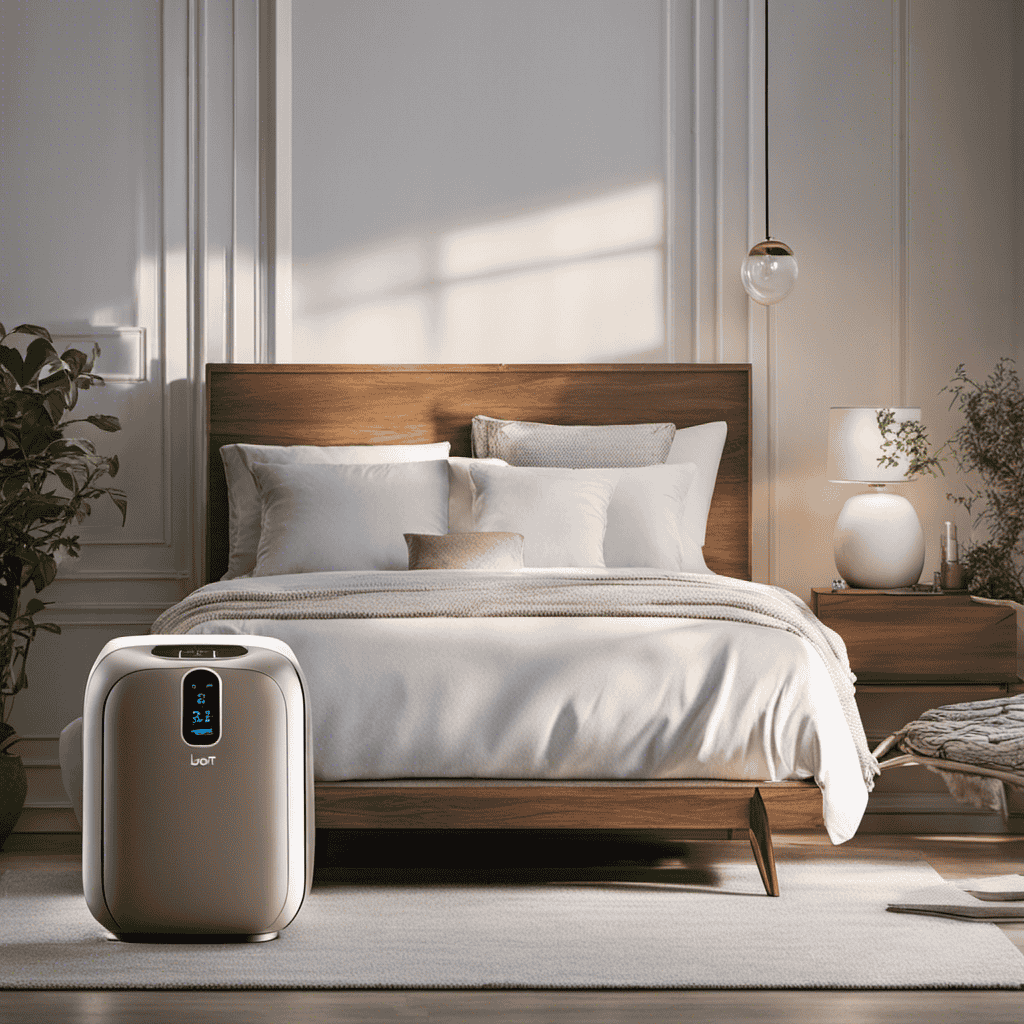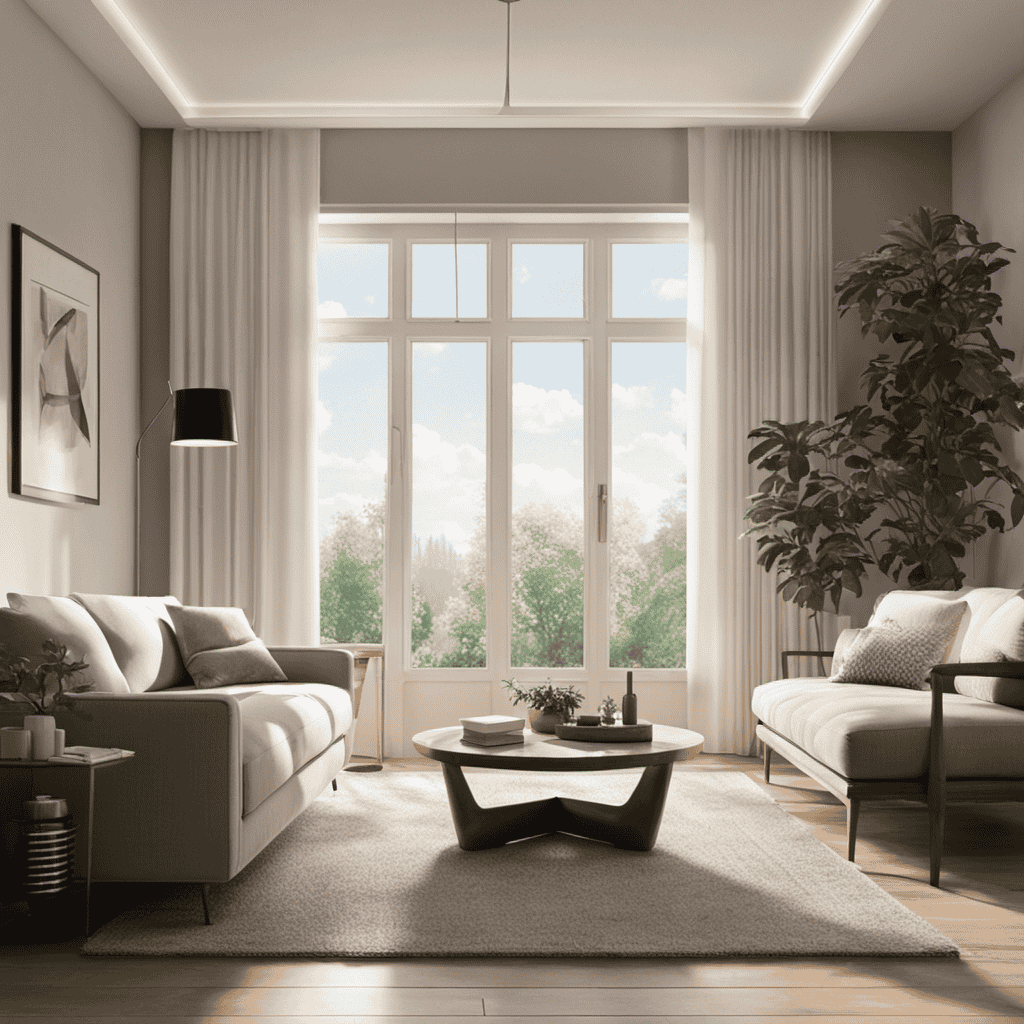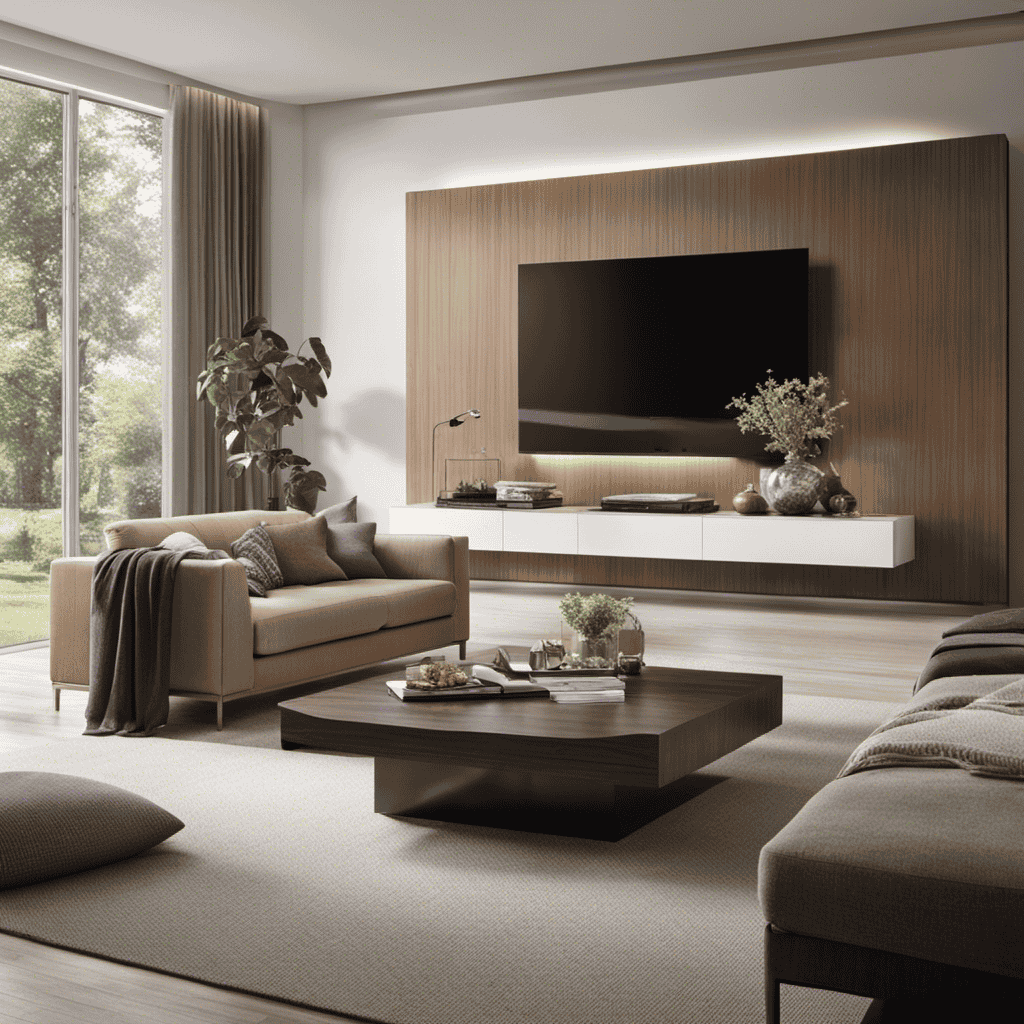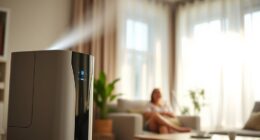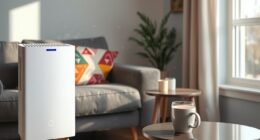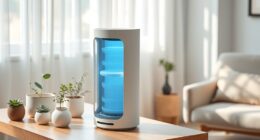As a person who prioritizes having clean and healthy indoor air, I often question the necessity of using an air purifier.
In a world where pollutants and allergens lurk in every corner of our homes, it is crucial to take measures to improve the air quality we breathe.
This article aims to shed light on the necessity of air purifiers by exploring their health benefits, their role in combating common indoor pollutants, and how they can provide relief from allergies and asthma.
So let’s dive in and discover why an air purifier is an essential addition to any home.
Health Benefits of Using an Air Purifier
Using an air purifier can help improve your overall health and well-being.
Indoor air pollution is a major concern, as it can contain harmful pollutants such as dust, pet dander, pollen, and volatile organic compounds (VOCs). Breathing in these pollutants can have detrimental effects on our respiratory health.
However, by using an air purifier, we can effectively remove these pollutants from the air we breathe, reducing the risk of respiratory issues such as allergies, asthma, and respiratory infections.
Studies have shown that air purifiers can significantly reduce the levels of indoor air pollutants, leading to improved lung function and overall respiratory health.
Investing in an air purifier is a proactive step towards creating a healthier indoor environment and safeguarding our respiratory well-being.
Common Indoor Air Pollutants and Their Effects
To make your home healthier, it’s important to be aware of common indoor air pollutants and how they can impact your well-being.
Indoor air pollution refers to the presence of harmful substances in the air we breathe inside our homes. These pollutants can come from various sources such as cooking, cleaning products, smoking, and even building materials.
Some of the most common indoor air pollutants include volatile organic compounds (VOCs), formaldehyde, radon, and particulate matter. Exposure to these pollutants can lead to a wide range of health risks, including respiratory problems, allergies, asthma, and even cancer.
Understanding the potential dangers of indoor air pollution is crucial in taking steps to improve the air quality in our homes. One effective way to achieve this is by using air purifiers, which help remove these pollutants and create a healthier living environment for you and your family.
How Air Purifiers Improve Indoor Air Quality
One way you can improve the quality of air inside your home is by using an air purifier. Air purifiers are effective in removing airborne pollutants, such as dust, allergens, pet dander, and smoke particles.
These devices work by using filters or technology, such as ionization or UV light, to capture or neutralize harmful particles in the air. Studies have shown that air purifiers can significantly reduce indoor air pollution, leading to improved respiratory health and reduced allergy symptoms.
To maintain the effectiveness of an air purifier, regular maintenance is necessary. This includes changing or cleaning the filters as recommended by the manufacturer, keeping the unit clean, and ensuring proper ventilation in the room.
Choosing the Right Air Purifier for Your Home
When it comes to choosing the right air purifier for my home, there are several key points that I need to consider.
Firstly, I need to ensure that the air purifier has effective filtration methods that can effectively remove pollutants and allergens from the air.
Secondly, I need to take into account the size of the room where I will be using the air purifier, as different models are designed to cover different room sizes.
Lastly, I also need to compare the noise levels of different air purifiers, as I want one that operates quietly without disturbing the peace in my home.
Effective Filtration Methods
There’s no denying that effective filtration methods are crucial when it comes to choosing an air purifier. With the increasing concern about indoor air pollution, it is important to ensure that the air we breathe is clean and safe. In order to achieve this, air purifiers need to have high filtration efficiency to effectively remove pollutants from the air.
Here are some key points to consider when evaluating the filtration methods of an air purifier:
-
HEPA Filters: Look for air purifiers that use High Efficiency Particulate Air (HEPA) filters, as they are highly effective in removing particles as small as 0.3 microns.
-
Activated Carbon Filters: These filters are excellent at removing odors, gases, and volatile organic compounds (VOCs) from the air.
-
Pre-filters: Pre-filters trap larger particles, such as dust and pet hair, prolonging the lifespan of the main filter.
-
Compliance with Air Quality Standards: Ensure that the air purifier meets the necessary air quality standards set by regulatory bodies to ensure its effectiveness.
Room Size Considerations
To ensure proper coverage, make sure you consider the size of the room when selecting an air purifier. Room size optimization is crucial for maximizing the effectiveness of your air purifier. A purifier that is too small for the room may not be able to filter the air efficiently, while a purifier that is too large for the room may use unnecessary energy and be less effective. To help you determine the appropriate air purifier size for your room, here is a table comparing room sizes and recommended purifier coverage:
| Room Size | Recommended Coverage |
|---|---|
| Small (up to 200 sq ft) | Purifier with coverage of 200 sq ft or more |
| Medium (200-400 sq ft) | Purifier with coverage of 400 sq ft or more |
| Large (400-600 sq ft) | Purifier with coverage of 600 sq ft or more |
| Extra Large (600+ sq ft) | Purifier with coverage of 800 sq ft or more |
Noise Level Comparison
When considering an air purifier for my home, I found it important to not only review the different models available but also compare their noise levels. After all, I don’t want a device that will disrupt my peaceful environment.
Based on my research, here is what I discovered:
- Some air purifiers operate at a whisper-quiet level, making them ideal for bedrooms or offices where silence is essential.
- Others produce a moderate hum, which may be suitable for living rooms or kitchens.
- There are also air purifiers that emit a louder noise, which could be more appropriate for areas with higher background noise or where the purifier is not in close proximity to where people spend most of their time.
- It’s important to read air purifier reviews to find out how different models compare in terms of noise levels.
In addition to noise levels, I also considered the energy consumption of each air purifier. By comparing energy consumption, I was able to find a model that not only met my noise preferences but also had a low energy consumption, helping me save on electricity bills.
The Role of Air Purifiers in Allergy Relief
Air purifiers can significantly reduce allergy symptoms by capturing and removing airborne allergens.
Numerous studies have demonstrated the effectiveness of air purifiers in reducing airborne allergens such as pollen, dust mites, pet dander, and mold spores.
These devices work by using filters to trap and neutralize these allergens, preventing them from circulating in the air and triggering allergic reactions.
In fact, a study published in the Journal of Allergy and Clinical Immunology found that the use of air purifiers led to a decrease in asthma symptoms and medication use for individuals with allergic asthma.
By removing allergens from the air, air purifiers provide a cleaner and healthier environment, allowing allergy sufferers to experience relief and improve their quality of life.
Moving forward, let’s explore how air purifiers can also play a crucial role in managing asthma symptoms.
Air Purifiers for Asthma Management
As someone who’s struggled with asthma for years, I understand the importance of finding effective methods for managing this condition.
One key solution that’s brought me considerable relief is the use of air purifiers. They not only help remove asthma triggers from the air but also ensure clean and healthy air quality in our homes.
When choosing the right air purifier for asthma management, it’s crucial to consider factors such as the type of filter used, the size of the room, and the specific needs of the individual.
Asthma Relief With Purifiers
You’ll find relief from asthma symptoms with purifiers.
As someone who has struggled with asthma for years, I can attest to the effectiveness of air purifiers in managing and preventing asthma attacks.
Here are some key reasons why purifiers are a valuable tool for asthma relief:
-
Purifiers remove airborne allergens: Dust mites, pollen, pet dander, and mold spores are common triggers for asthma attacks. Air purifiers with HEPA filters can effectively capture and remove these allergens, reducing the risk of asthma symptoms.
-
Purifiers eliminate indoor pollutants: Indoor air pollution, caused by volatile organic compounds (VOCs), smoke, and chemicals, can worsen asthma symptoms. Purifiers equipped with activated carbon filters can absorb and neutralize these pollutants, providing cleaner air for asthma sufferers.
-
Purifiers maintain optimal humidity levels: Dry or humid air can irritate the airways and trigger asthma symptoms. Some purifiers are equipped with humidifiers or dehumidifiers, allowing you to control and maintain the ideal humidity levels in your home.
-
Purifiers promote better sleep: Poor indoor air quality can disrupt sleep patterns and exacerbate asthma symptoms. By improving air quality, purifiers can help asthma sufferers achieve better sleep, leading to reduced inflammation and better overall health.
Benefits of Clean Air
To experience the benefits of clean air, it’s important to ensure that your living environment is free from pollutants and allergens. Clean air has numerous benefits for our health and well-being. Studies have shown that breathing in clean air can reduce the risk of respiratory diseases such as asthma and allergies. It can also improve lung function and cardiovascular health.
Clean air is especially important for vulnerable populations such as children, the elderly, and those with pre-existing respiratory conditions. Additionally, clean air can enhance cognitive function, increase productivity, and improve sleep quality. With all these benefits, it is clear that maintaining good air quality is crucial for our overall health and quality of life.
Now that we understand the importance of clean air, let’s explore how to choose the right air purifier model.
Choosing the Right Model
Now that we understand the benefits of clean air, let’s dive into the process of choosing the right air purifier. There are several key features to consider when making this decision:
-
Filter type: Look for models with high-efficiency particulate air (HEPA) filters, as they are proven to remove the most pollutants from the air.
-
Coverage area: Consider the size of the room you want to purify and choose a model that can effectively clean the air in that space.
-
Noise level: Some air purifiers can be quite noisy, so if you plan on using it in a bedroom or office, look for a quieter option.
-
Smart features: Many modern air purifiers come with smart features like remote control, programmable timers, and air quality sensors.
When it comes to price ranges, air purifiers can vary significantly. Basic models can be found for around $100, while more advanced models with additional features can cost upwards of $500. It’s important to find a balance between your budget and the features that are most important to you.
Eliminating Odors With an Air Purifier
If you’re experiencing unpleasant odors in your home, an air purifier can help eliminate them. Odors can come from various sources such as cooking, pets, or even mold and mildew.
An air purifier works by filtering the air and removing particles that contribute to these odors. It improves indoor air quality by trapping and neutralizing the odor-causing molecules. The filters in an air purifier are designed to capture even the smallest particles, including volatile organic compounds (VOCs) that are responsible for many odors.
The Importance of Air Purifiers in Pet-friendly Homes
Having pets in your home can lead to lingering odors that an air purifier effectively eliminates, creating a fresher environment for you and your furry companions. As a pet owner, I understand the importance of maintaining a clean and allergen-free living space.
Here are a few reasons why air purifiers are essential in pet-friendly homes:
-
Pet dander control: Air purifiers are equipped with filters that capture pet dander, reducing the amount of allergens in the air.
-
Reducing pet allergies: By removing pet dander and other allergens from the air, air purifiers can help alleviate symptoms of pet allergies for both humans and pets.
-
Odor elimination: Air purifiers are designed to eliminate pet odors, leaving your home smelling fresh and clean.
-
Improved indoor air quality: With an air purifier, you can ensure that the air you and your pets breathe is clean and free from harmful particles.
Understanding the different types of air purification technologies will further enhance your ability to choose the right air purifier for your pet-friendly home.
Understanding the Different Types of Air Purification Technologies
Understanding the various types of air purification technologies can help you choose the right one for your pet-friendly home.
When it comes to filtration technologies, there are a few options to consider. The most common types include HEPA filters, activated carbon filters, and ionizers.
HEPA filters are highly effective at removing pet dander, pollen, and other airborne particles, making them a popular choice for pet owners.
Activated carbon filters are great for eliminating odors, which can be a common problem in pet-friendly homes.
Ionizers, on the other hand, work by emitting negatively charged ions that attach to airborne particles, causing them to drop from the air.
It’s important to note that while all these technologies are effective in their own ways, HEPA filters are generally considered the most efficient when it comes to air purification.
Frequently Asked Questions
Can Air Purifiers Cure or Prevent Respiratory Illnesses?
Air purifiers can help prevent respiratory illnesses by filtering out harmful particles in the air. However, their ability to cure or completely prevent such illnesses is not well-established, as more efficacy studies are needed.
How Long Do Air Purifiers Last Before Needing to Be Replaced?
Air purifiers typically last for about 5-10 years before needing to be replaced. Signs that indicate the need for replacement include reduced effectiveness in removing pollutants, strange noises, and frequent breakdowns.
Are There Any Potential Health Risks or Side Effects Associated With Using Air Purifiers?
Using an air purifier can have potential dangers and long-term effects on your health. It is important to consider the risks and side effects before using one to ensure your well-being.
Do Air Purifiers Remove All Types of Indoor Pollutants, Including Gases and Chemicals?
Yes, air purifiers can remove various types of indoor pollutants, including gases and chemicals. They are effective in reducing allergens and volatile organic compounds (VOCs), which can have negative health effects.
Can Air Purifiers Eliminate Pet Dander and Hair Completely From the Air?
Yes, air purifiers can eliminate pet dander and hair from the air. They act like a vacuum cleaner, sucking up allergens and reducing the risk of allergies and asthma attacks caused by pet allergens.
Conclusion
In conclusion, air purifiers are essential for maintaining a healthy and clean indoor environment. They play a crucial role in removing common indoor pollutants, such as allergens, dust, and odors, improving the overall air quality in our homes.
Whether you suffer from allergies or asthma, or simply want to create a pet-friendly environment, there is a suitable air purifier for your needs. By understanding the different types of air purification technologies available, we can make an informed decision and ensure that our homes remain fresh and pollutant-free.
